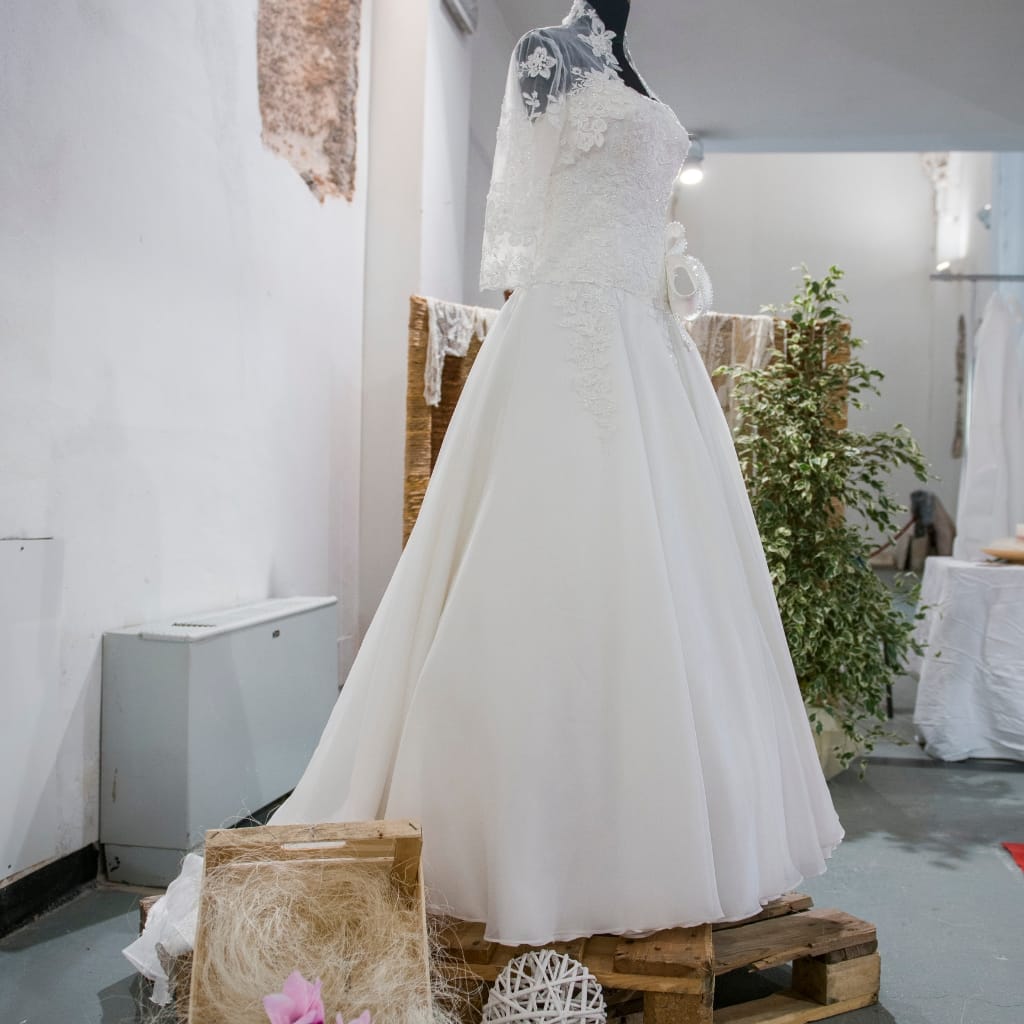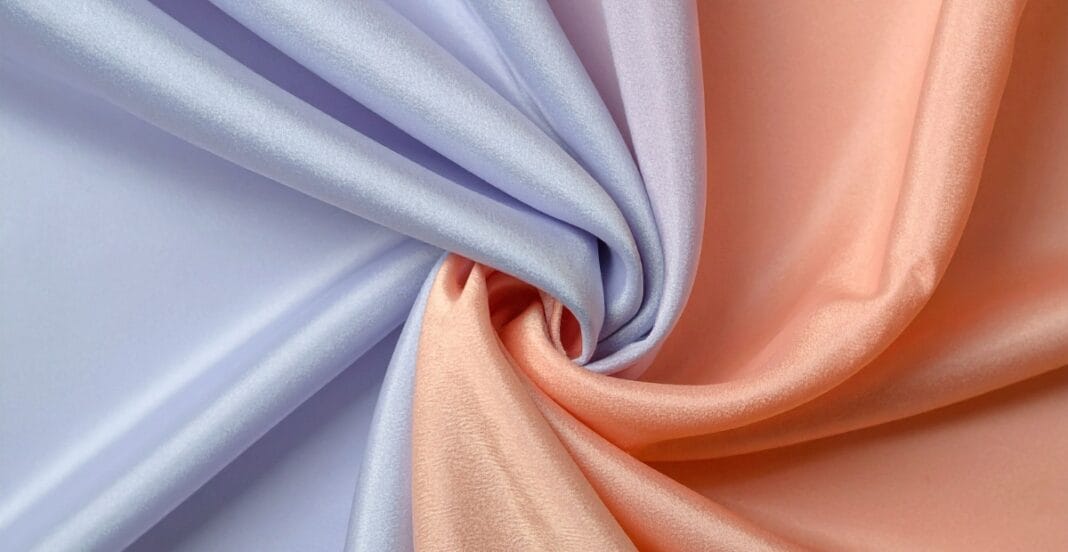Few materials feel as weightless or as graceful as pure chiffon. It dances on the slightest breeze. It spills across the body like water. Yet it brings a whispering elegance to every dress or décor. Whether draped on a bridal silhouette, spotlighted on a runway, or stacked in a swish skirt, chiffon always etches itself in memory.
Where sturdier cloths chase comfort or longevity, chiffon quietly pursues class. Soft, translucent, and somewhat dreamy, it is the go-to choice whenever an occasion calls for something unforgettable. But what precisely counts as pure chiffon? And what keeps it in vogue after so many centuries?
The piece that follows dives into every facet of this lovely textile. From its production to its touch and its best applications, here is your full guide to the light, sheer, and enchanting realm of pure chiffon.
Table of contents
What Is Pure Chiffon Fabric?
Pure chiffon is an airy, almost translucent cloth that seems to float. Its plain weave leaves tiny ridges that enhance transparency and breathability. The term comes from French, simply meaning cloth. Thanks to its tender hand and refined look, chiffon remains a favorite for haute couture and elegant occasions.
True chiffon is normally woven from 100-percent silk, setting it apart from factory-made versions that rely on polyester or nylon. The silk type feels lovelier against the skin, breathes more freely, and radiates an understated elegance. Its surface catches the light in a soft glimmer that complements the fabric’s easy, flowing silhouette.
Yet those fine threads and open weave leave the cloth feeling just a bit textured, not perfectly smooth. The sensation arises because each yarn is twisted tightly-in fact, the yarns turn in opposite directions, the process known as crepe twisting. These spirited twists confer strength, shape, and the signature airy movement without sacrificing fragility.
From saris to headscarves and from evening gowns to bridal veils, authentic silk chiffon bestows a rare, graceful charm that few textiles can equal. Because of its delicate beauty and light weight, chiffon is sought by designers who wish to honour the wearers poise.

How Pure Chiffon Fabric Is Made
The journey begins with a skilled mill spinning almost invisibly fine threads. When the goal is pure silk chiffon, those strands come entirely from silk cocoons. The individual silk fibers are twisted tightly in opposing directions. This technique, called crepe twisting, produces the fabric’s trademark ripple and stops it from resting too flat.
Next, the threads are set into a plain weave, meaning each strand passes steadily over one and then under the other in strict alternation. This orderly crossing leaves tiny gaps that admit light, so the cloth remains sheer yet surprisingly strong.
After weaving, the fabric receives finishing treatments: a gentle wash, mild bleach, or subtle dyeing to enhance color and soften texture. In the end, the cloth feels almost weightless, holds its shape, and is simply called chiffon. Once approved, it is cut for draping, stitched into garments, or rolled on bolts for designers.
These steps together demand skill and patience, making pure silk chiffon pricier than machine-made synthetics that skip much of the labor. For makers and wearers, though, the characteristic glow, quiet drape, and whisper of softness justify the extra cost.
Touch is perhaps chiffon s loudest voice, speaking through soft, dry skin contact. Pure silk chiffon slips across the body without clinging or tugging. The faint texture from the crepe twist barely registers yet keeps the fabric alive.
Thanks to its near-empty density, chiffon floats on air, seizing every stray breath or idle movement. Wind bends it like a leaf, dance lifts it like a petal. That buoyancy suits any style meant to shift, sway, or trail with the wearer- layered dresses, open capes, gathering sleeves, or a simple scarf.
When sewn into a garment, chiffon sits softly on the skin. The weave neither grips nor presses, letting the cloth move freely. Instead, it builds a sense of volume while feeling nearly weightless. For this reason, designers prize chiffon; it adds fluid motion to even the most basic cut.
Unlike denser silks or stiff cottons, chiffon drifts above the body. It appears to hover, creating space rather than shape. That quality explains its use in evening gowns, bridal dresses, and stage costumes. Each piece takes on a dreamlike aura the moment chiffon enters the mix.

Common Uses of Pure Chiffon Fabric
Chiffon is nearly everywhere in modern fashion and interior design. Because the fabric looks refined, it dominates dressy clothing. Wedding gowns, bridesmaid outfits, and cocktail dresses often sport airy chiffon layers. These overlays supply extra depth while keeping the overall look light.
Pure chiffon also appears in scarves, shawls, and lightweight wraps. The fabric envelops wearers softly, adding splash and texture without bulk. It folds neatly into a small handbag and surprises owners by resisting wrinkles.
In many traditional costumes, chiffon shows off its charm as well. Indian sarees, Pakistani dupattas, and bridal veils dance in the breeze and look ethereal. The sheer base complements delicate embroidery, fine lace, and shimmering beadwork perfectly.
Chiffon adds a special touch throughout the home, too. Sheer panels cut from the cloth blur harsh sunlight and lend a graceful air. Similarly, runners and accent overlays sparkle softly, thanks to the fabric’s light-catching surface.
Across outfits, add-ons, or interior pieces, chiffon carries a classic appeal that feels fresh with every look

Advantages of Working with Pure Chiffon Fabric
It is easy to see why chiffon has endured for hundreds of years. Pure chiffon blends visual delight with practical behaviour. The cloth is light enough for summer yet sturdy enough for regular wear.
First, it breathes. The open weave lets air circulate freely. That feature suits garden parties or tropical destinations. You stay cool while looking polished.
Second, it holds wrinkles better than many expect. The twisted yarns spring back into place after brief folding. Although some care is still needed, chiffon crumples far less than cotton or linen.
Third, it accepts dye with striking results. Silk chiffon drinks in pigment deeply, delivering rich, uniform tones. Those colours shimmer in a way most synthetics simply cannot.
Pure chiffon is the fabric equivalent of the perfect little black dress. Because it drapes loosely rather than hugging the body, it glides over every contour without emphasizing any single spot. The result is an airy, forgiving ease that reads as casual elegance.
Caring for Pure Chiffon Fabric
Despite its charming lightness, silk chiffon is fragile and demands thoughtful handling. Follow these steps and the cloth will retain its beauty for decades.
Begin by steering clear of the washing machine. Fill a basin with cool water and a mild, silk-friendly detergent, then swirl the garment gently. Never add bleach or any strong soap; those chemicals weaken silk threads.
Rinse the piece until the water runs clear. Do not twist or yank it to remove water; that stretches the weave. Instead, sandwich the fabric between clean, absorbent towels and press lightly. Finally, lay the garment flat or hang it in the shade until completely dry.
If wrinkles remain, set the iron to its coolest silk setting. Slip a fine cloth between the hot plate and the chiffon to shield the fibers. A fine mist of steam is even kinder, letting moisture relax the fabric without squashing its structure.
Store chiffon pieces on padded hangers, allowing the silk to breathe. Should you fold them, lay acid-free tissue between each creases to ward off sharp lines. Above all, keep the garments dry, dust-free, and out of direct sun.
Attend to these simple chores and your pure chiffon will keep shining, soft, and timeless.
Pure Chiffon vs Synthetic Chiffon
Many shoppers mistakenly treat pure chiffon and its synthetic cousins as identical friends. Although their surfaces can trick the eye, their touch and long-term wear tell different stories.
Real chiffon is woven from silk fibres, giving it a supple hand, generous breathability, and the subtle shimmer light loves. Yes, it costs more, yet most makers agree that its drape proves worth the extra cash.
Because silk is a natural product, pure chiffon breaks down harmlessly at the end of its life.
In contrast, synthetic chiffon usually springs from polyester or nylon, so the metre price stays low. Laundry days are simpler too, since water and tumble dryers rarely harm the fabric.
However, synthetics resist airflow, feeling hot against the body on muggy days. Their surfaces can seem slightly rigid or scratchy, and dyes may settle into the fibre less richly.
For everyday garments and accessories, the synthetic version handles business just fine. When the occasion calls for a wedding dress, lavish evening wear, or simply the softest layer next to skin, pure chiffon delivers an experience that polymers seldom match.
Being able to tell one from the other will steer you toward wiser purchases and projects. Whether you sew, shop, or design, the right choice of chiffon can shape the final look in surprising ways.

When to Use Pure Chiffon Fabric
Reach for pure chiffon whenever polished elegance is the aim. It reigns supreme in bridal gowns, prom dresses, and red-carpet showstoppers alike. The fabrics soft glow and weightless drape lend each step, turn, or twirl an effortless grace that few materials can rival.
Pure chiffon fabric suits warm-weather wardrobes perfectly. Chiffon blouses, skirts, and maxi dresses let air circulate and still look neat. They fold flat in a suitcase, dry quickly, and weigh almost nothing.
Even in laid-back environments, chiffon lifts an ordinary outfit. A plain chiffon scarf or light top introduces instant polish. Genuine chiffon lends an aura of refinement to almost anything.
Yet the cloth is not suited to sharply tailored pieces. Because it lacks rigidity, it will not hold crisp lines. Chiffon works best in styles that drape, billow, and layer freely.
Wear the fabric where ease, coolness, and a gentle touch matter most. You will never regret the decision to select chiffon.
Conclusion
Pure chiffon is far more than a simple textile. It embodies lightness, elegance, and a beauty that endures. Generations of queens, brides, dancers, and couturiers have celebrated its charm. Today, designers still turn to chiffon for fresh, inspiring silhouettes.
It feels luxuriously soft against the skin. It moves with you, rolling and spilling like water. Its versatility suits moods from dreamy romance to sleek runway. Whether reserved for a wedding or an ordinary Tuesday, chiffon adds quiet grace.
Choosing chiffon means picking comfort without sacrificing style. It offers a texture rich in history yet modern in effect. Above all, it moves with life itself, every step, breeze, and gesture.
Next time you desire fabric that is lovely, weightless, and almost transparent, consider chiffon.
FAQs
Yes. Pure chiffon refers specifically to chiffon made from 100% silk fibers.
Not if it’s pure chiffon. Hand wash in cold water with mild detergent to protect the fabric.
Absolutely. It’s breathable, lightweight, and perfect for warm-weather wear.


